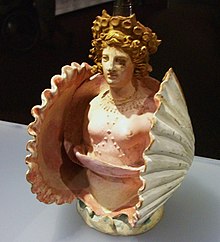Phanagoria
Φαναγόρεια (in Ancient Greek) | |||||||||||||||||||||||||
St. Petersburg .
Phanagoria ( Cimmerian Bosporus .
The city was a large Genoese colony under the name Matrega, it remains a Latin Catholic titular see .
Today the site is located at a short distance to the west of Hermonassa, lies 25 kilometres (16 mi) to the west, on the shoreline of modern Taman .
HistoryAntiquity Phanagoria was founded ca. 543 BC by the Asia Minor in consequence of their conflict with the Persian king Cyrus the Great. The city took its name after one of these colonists, Phanagoras. "The unusual nature of the Taman peninsula near Phanagoria, with its ravines, crevices, hills, and low cones of active volcanoes, must have impressed the ancient colonists even more than it impresses us today", historian Yulia Ustinova has observed.[2]
In the 5th century BC, the town thrived on the trade with the Cimmerian Bosporus. By the first centuries AD, Phanagoria had emerged as the main centre of the kingdom.[citation needed ]
During the Dynamis honored Augustus as "the emperor, Caesar, son of a god, the god Augustus, the overseer of every land and sea".[3] The loyalty to Rome allowed Phanagoria to maintain a dominant position in the region until the 4th century, when it was sacked and destroyed by the invading Huns.[citation needed ]
Middle AgesBy the 7th century, the town had recovered from a century of invasions from the steppe peoples. It served as the capital of Old Great Bulgaria between 632 and 665 under Kubrat.[citation needed] Afterwards Phanagoria became (at least nominally) a ]In the 10th century, the town seems to have faced an invasion, supposedly by the Rus. After that, Phanagoria could not compete in significance with neighboring Tmutarakan.[citation needed] In the late de Ghisolfi dominions. Henceforth there has been no permanent settlement on the site.[citation needed ]
Ecclesiastical historyThe Genoese colony was canonically established on 1349.02.21 as Metropolitan Archdiocese of Matriga. It was suppressed around 1400 AD.
Titular seeThe diocese was nominally restored as a Latin Catholic titular bishopric in 1928 under the name Matriga, which was changed in 1929 already to Matrega.
It is vacant, having had the following incumbents, all of the lowest (episcopal) rank :
Excavations The location of Phanagoria was determined in the 18th century, when marble statue bases with dedications to Aphrodite were discovered there. Hecataeus and Strabo mention a local sanctuary of Aphrodite as the largest in the Pontic region.[4] Archaeological exploration of the site started in 1822, when "soldiers dug into a large barrow, making rich discoveries of gold and silver objects, many unique, which they divided up between themselves".[5] Apart from the ancient city itself, archaeologists have been interested in a vast necropolis, which spreads on three sides around Phanagoria. There are thousands of burials, many with cypress or marble sarcophagi — an indication of the well-being of the ancient Phanagorians. Excavations conducted in the 19th century were for the most part amateurish; as many as twelve kurgans would be razed each season. Some of the most intriguing finds were unearthed in the 1860s at the Bolshaya Bliznitsa tumulus, classed by Michael Rostovtzeff as a feminine necropolis with three vaults. One of the royal kurgans near Phanagoria "has a stone stairway leading down to a rectangular passageway, the entrance to the burial chamber (3.70 × 3.75 × 4.70 m). These two areas are covered by an arch showing remains of painted decoration. The wall frescos imitate encrusted marble. On either side of the entrance to the tomb long stone boxes contain four horse burials along with rich grave gifts; saddlery and harnesses of gold and gilded bronze."[6] Vladimir Blavatsky resumed excavations of Phanagoria in 1936. Among the recent finds is an inscription indicating that a synagogue existed in Phanagoria as early as 51 AD. Underwater investigation of the site has revealed multiple fragments of architectural structures. In 2009 was discovered the palace of Mithridates VI.[7] In 2021, archaeologists discovered coins in the broken neck of an amphora. They are thought to have been minted in the late 3rd or early 4th century and circulated through the 6th century. The coins are thought to have been hidden before an attack by the Huns or the Turks, who burned and destroyed large parts of the city. Most probably an early Christian basilica stood on the site where the coins were found.[8] In 2023, archaeologists announced "the discovery of one of the world’s oldest altars, and marble stele fragments," making it one of the earliest, if not the earliest synagogue ever uncovered outside of Israel.[9]
HonoursPhanagoria Island in Antarctica is named after Phanagoria.[10] Notable people
See alsoReferences
Further reading
External links
| |||||||||||||||||||||||||
| |||||||||||||||||||||||||
| |||||||||||||||||||||||||
| |||||||||||||||||||||||||
